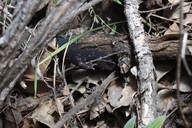|
Aneides iecanus (Cope, 1883)
Shasta Black Salamander | family: Plethodontidae subfamily: Plethodontinae genus: Aneides |
| Species Description: Reilly SB, Wake DB. 2019. Taxonomic revision of black salamanders of the Aneides flavipunctatus complex (Caudata: Plethodontidae). PeerJ 7:e7370 https://doi.org/10.7717/peerj.7370; Cope, E. D. 1883. Notes on the geographical distribution of Batrachia and Reptilia in western North America. Proceedings of the Academy of Natural Sciences of Philadelphia 35: 10–35. | |
 © 2024 Noah M. Morales (1 of 19) |
|
|
|
Description Aneides iecanus is a moderately sized, robust, speckled black salamander. Males have snout-vent lengths ranging from 69.9 – 81.6 mm (mean 75.8 mm) while females range from 60.9 – 78.7 mm (mean 70.1 mm). They are morphologically similar to the other members of the Aneides flavipunctatus complex. Similar to other Aneides species, the heads are large and laterally expanded behind the eyes, creating a triangular appearance. The head width in males ranges from 11.0 - 13.3 mm (mean 12.5 mm), while head length in females ranges from 8.9 - 10.8 mm (mean 10.0 mm). The jaws of A. iecanus are strong and prominent jaw musculature is often present. Nasolabial grooves are present (Reilly and Wake 2019). Cope (1883) reports 13 costal grooves. The limbs are moderately long and robust. Males have a combined limb length from 26.5 – 35.9 mm (mean 30.0) and females from 27.0 – 33.0 (mean 30.6 mm) (Reilly and Wake 2019). The limbs are separated by three intercostal spaces (Cope 1883). The digits are slender, long, and terminally expanded. The tails are robust and moderate in length, the longest reaching up to 85% of the snout-vent length in males and 78% in females. The tails are capable of regeneration (Reilly and Wake 2019). DIAGNOSIS: Aneides iecanus is very similar in body size and shape to the other members of the Aneides flavipunctatus complex (A. flavipunctatus, A. klamathensis, and A. niger), but can be distinguished by heavy speckling across the whole salamander and geographic range. Additionally, A. iecanus has an average of 16 trunk vertebrae, while A. klamathensis and A. niger have 17. Aneides iecanus is distinguished from A. aeneus by its larger size, rounded rather than flattened head and body, more robust appearance, shorter limbs and digits, and black coloration. Aneides hardii is much smaller and less robust than A. iecanus. Aneides ferreus and A. vagrans are smaller and have a less robust but more prehensile tail, and longer digits and limbs than A. iecanus. Aneides lugubris is larger, has a lighter coloration, less robust but more prehensile tail, and longer limbs and digits than A. iecanus. No other Aneides species occurs in sympatry with A. iecanus (Reilly and Wake 2019). COLORATION: Aneides iecanus is a black salamander with moderate to heavy white speckling throughout the head, body, and tail. Both adults and juveniles exhibit this coloration, though juveniles are sometimes slightly lighter than adults (Cope 1883, Reilly and Wake 2019). VARIATION: Sexual dimorphism is present as size differences between males and females. Males are on average 5.7 mm longer in snout-vent length than females. Male heads are on average of 2.5 mm wider than females. Combined limb length is nearly identical in males and females, with females averaging 0.6 mm more than males. Tails tend to be longer relative to body size in males than females. Males also tend to have more prominent jaw musculature (Reilly and Wake 2019). Distribution and Habitat Country distribution from AmphibiaWeb's database: United States U.S. state distribution from AmphibiaWeb's database: California
Aneides iecanus prefers shaded, streamside habitat, found typically in the vicinity of creeks and small canyons in forested areas (Reilly and Wake 2019). Life History, Abundance, Activity, and Special Behaviors Reproduction is terrestrial. However, courtship and breeding behavior are not very well-studied in the A. flavipunctatus complex. It is assumed that females lay approximately 8 - 25 eggs in moist cavities below the ground in the summer and stay with the eggs until they hatch (McGinnis and Stebbins 2018). Aneides iecanus preys upon mostly small arthropods along the ground (McGinnis and Stebbins 2018). Trends and Threats Full survey work has never been completed for the species and is needed to determine the distribution, population size, and level of protection needed for long-term persistence (Reilly and Wake 2019). Relation to Humans Possible reasons for amphibian decline Dams changing river flow and/or covering habitat Comments Aneides iecanus was initially described as Plethodon iecanus (Cope 1883). It was later moved into Aneides before being synonymized with A. flavipunctatus. Multiple genetic studies between 1980 and 2019 showed that the Shasta County population was divergent from the other A. flavipunctatus populations, eventually leading to the 2019 redescription as A. iecanus. Aneides niger and A. klamathensis were also split from A. flavipunctatus and raised to species status at the same time, forming a four species complex (Reilly and Wake 2019). Etymology: Its specific epithet is derived from the local Native American word “Iëka”, which according to Cope's original description of "Plethodon iëcanus", refers to Mount Shasta (Reilly and Wake 2019).
References
Reilly, S.B., Wake D.B. (2019). "Taxonomic revision of black salamanders of the Aneides flavipunctatus complex (Caudata: Plethodontidae)." PeerJ, 7, e7370. [link] Originally submitted by: Michelle S. Koo (2021-11-05) Description by: Michelle S. Koo (updated 2021-11-05)
Distribution by: Michelle S. Koo (updated 2021-11-05)
Life history by: Michelle S. Koo (updated 2021-11-05)
Trends and threats by: Michelle S. Koo (updated 2021-11-05)
Relation to humans by: Michelle S. Koo (updated 2021-11-05)
Comments by: Michelle S. Koo (updated 2021-11-05)
Edited by: Michelle S. Koo (2025-05-02) Species Account Citation: AmphibiaWeb 2025 Aneides iecanus: Shasta Black Salamander <https://amphibiaweb.org/species/9047> University of California, Berkeley, CA, USA. Accessed May 18, 2025.
Feedback or comments about this page.
Citation: AmphibiaWeb. 2025. <https://amphibiaweb.org> University of California, Berkeley, CA, USA. Accessed 18 May 2025. AmphibiaWeb's policy on data use. |


 Map of Life
Map of Life